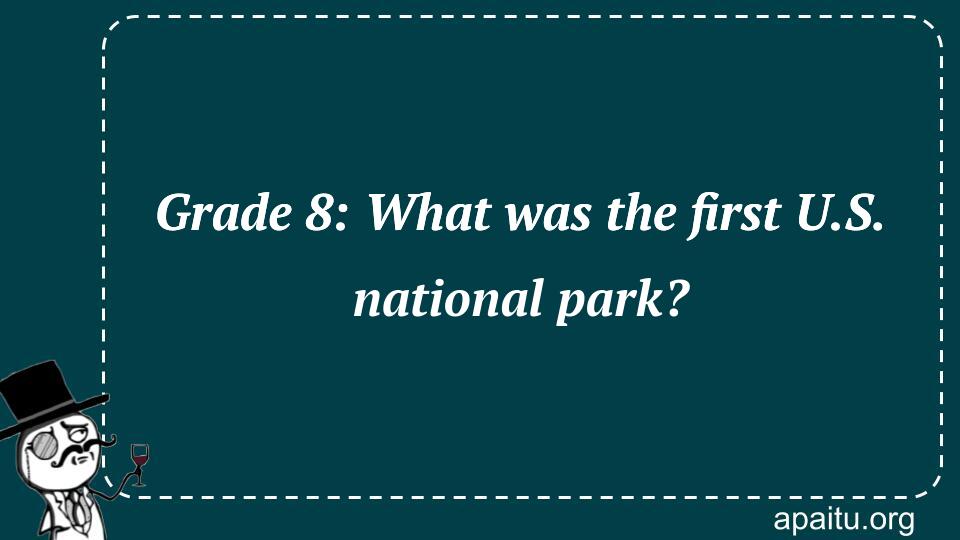Question
Here is the question : GRADE 8: WHAT WAS THE FIRST U.S. NATIONAL PARK?
Option
Here is the option for the question :
- Glacier
- Yellowstone
- Grand Canyon
- Everglades
The Answer:
And, the answer for the the question is :
Explanation:
Yellowstone National Park, spanning 2 million acres, is America’s first national park. The huge region was dedicated on March 1, 1872, under the Yellowstone National Park Protection Act, signed by President Ulysses S. Grant. It is located in parts of Wyoming, Montana, and Idaho. Today, 63 protected places have been designated as national parks.

In the vast expanse of the United States, nestled amidst the breathtaking landscapes of Wyoming, Montana, and Idaho, lies the world’s first national park: Yellowstone. Established in 1872, Yellowstone National Park holds a unique place in American history, conservation efforts, and the preservation of natural wonders. Let’s embark on a journey to explore the origins, significance, and wonders of this iconic national park.
Yellowstone National Park spans over 2.2 million acres, encompassing a diverse range of ecosystems, geothermal features, and wildlife habitats. The park is renowned for its majestic mountains, expansive forests, cascading waterfalls, and, most notably, its geothermal wonders, including the famous Old Faithful geyser. This natural wonderland draws millions of visitors each year, offering an immersive experience in the heart of unspoiled wilderness.
The history of Yellowstone as a national park traces back to the 19th century, when the region’s remarkable natural beauty captured the imagination of explorers and adventurers. In 1871, a team of explorers led by Ferdinand V. Hayden ventured into the Yellowstone region and returned with captivating stories of geysers, hot springs, and extraordinary wildlife. Their accounts, coupled with the efforts of influential figures like artist Thomas Moran and photographer William Henry Jackson, ignited public interest and support for the preservation of this remarkable landscape.
Recognizing the significance of Yellowstone’s natural wonders and the urgent need to protect them, the United States Congress passed the Yellowstone National Park Act on March 1, 1872. With the stroke of President Ulysses S. Grant’s pen, Yellowstone became the world’s first national park, set aside for the enjoyment and preservation of future generations.
The establishment of Yellowstone as a national park marked a turning point in the history of conservation. It set a precedent for the protection of natural landscapes, inspiring the creation of a vast network of national parks and protected areas across the United States and around the world. Yellowstone’s designation as a national park was a testament to the belief that certain places possess such extraordinary beauty and ecological value that they should be safeguarded for all to appreciate.
Within Yellowstone’s boundaries lies an incredible array of natural wonders. The park is home to the largest concentration of geysers and hot springs on Earth, including the iconic Old Faithful, which spouts water and steam high into the air at regular intervals. The vibrant and colorful Grand Prismatic Spring, the stunning Lower Falls of the Yellowstone River, and the dramatic Yellowstone Caldera are just a few of the mesmerizing sights that await visitors in this extraordinary destination.
Beyond its geothermal features, Yellowstone boasts an impressive diversity of wildlife. The park is a sanctuary for numerous species, including grizzly bears, wolves, elk, bison, and the elusive gray wolf. Yellowstone’s wildlife population and ecosystem dynamics have been carefully studied and managed, contributing invaluable knowledge to the field of conservation biology.
Yellowstone National Park is not only a place of natural wonders but also a testament to the power of conservation and the importance of preserving our planet’s precious resources. Over the years, the park has faced various challenges, including wildfires, invasive species, and the delicate balance between human visitation and wildlife protection. However, through dedicated efforts, scientific research, and public awareness, Yellowstone continues to thrive as a symbol of environmental stewardship and a living laboratory for understanding the complexities of nature.
Yellowstone remains an awe-inspiring destination that captivates visitors from around the world. Its grandeur, biodiversity, and geothermal features make it a must-visit location for nature enthusiasts, adventurers, and those seeking solace in the serenity of the great outdoors. The park offers a multitude of recreational activities, including hiking, camping, wildlife watching, and photography, ensuring that every visitor can forge their own unforgettable memories within this natural wonderland.
Yellowstone National Park holds the esteemed title of the first national park in the United States and the world. Its establishment paved the way for the conservation movement, highlighting the importance of preserving and protecting natural landscapes for future generations. Yellowstone’s geothermal wonders, diverse ecosystems, and abundant wildlife make it a symbol of natural beauty and a testament to the power of conservation. As we continue to appreciate and safeguard this remarkable national park, let us be inspired to cherish and protect the natural wonders that grace our planet.